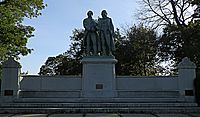Goethe–Schiller Monument (Milwaukee) facts for kids
The Goethe–Schiller Monument is a large public statue in Washington Park in Milwaukee, Wisconsin, United States. It was created by the German artist Ernst Friedrich August Rietschel. This bronze sculpture, made in 1908, shows two famous men: Johann Wolfgang von Goethe and Friedrich von Schiller. One holds a laurel wreath, a symbol of victory or honor, and the other holds a scroll.
The statue is 12 feet tall and sits on a granite base that is 26 feet long. This bronze sculpture is actually a copy of a statue that was first made in 1857 for the Goethe-Schiller Monument in Weimar, Germany.
Contents
What the Monument Looks Like
The Goethe-Schiller Monument shows two men standing next to each other. The older man, Johann Wolfgang von Goethe, is giving a laurel wreath to the younger man, Friedrich von Schiller. Schiller holds a scroll in his left hand.
Goethe wears a long coat that reaches his knees. He also has a shirt with ruffles, a vest, and leggings. Schiller wears a coat that goes down to his mid-calf, along with a vest and leggings.
The Base and Inscriptions
The statue stands on a tall, stepped granite base. This base has a curved bench area called an exedra. There are three messages carved into the sculpture and its base.
On the bottom left side of the sculpture, it says: RIETSCHEL, ERNEST F. This is the artist's name.
On the front of the statue's stand, it says in carved letters: GOETHE SCHILLER.
On the very front of the base, it also says: GOETHE SCHILLER.
The granite base also has three special plaques.
Plaque on the Left
The plaque on the left side has lines from Goethe’s famous play, Faust. It says:
- Was Du ererbt von Deinen
- Vätern hast Erwirb es,
- um es zu besitzen
- Johann Wolfgang von Goethe
- 1749–1832
- Weltbürger – World Citizen
This means: "That which you inherit from your fathers / You must earn in order to possess." It reminds us that things passed down to us are truly ours only when we work for them.
Plaque on the Right
The plaque on the right side has words from Schiller's play, Wallenstein. It says:
- Wer nichts waget
- der darf nichts hoffen
- Friedrich von Schiller
- 1759–1805
This means: "Who dares nothing, need hope for nothing." It teaches us that to achieve something, you must be brave and take risks.
Plaque in the Center
The plaque in the middle tells us about the monument's history:
- Erected by the German Citizens of Wisconsin
- and dedicated to the city-June 14, 1908
- Rededicated September 4, 1960
- German-American Societies of Milwaukee, Wisconsin
- Johann Wolfgang von Goethe's 250th birthday
- August 28, 1749
- celebrated on August 1, 1999 by the
- German-American Societies of Milwaukee, Wisconsin
This plaque shows that the monument was a gift from German citizens in Wisconsin. It also notes when it was first put up, when it was rededicated, and a special celebration for Goethe's 250th birthday.
The Milwaukee County Department of Parks, Recreation and Culture takes care of the Goethe-Schiller Monument.
Why This Monument is Important
Johann Wolfgang von Goethe and Friedrich von Schiller were very important German poets, writers, and playwrights. They became good friends in Weimar, Thuringia. Many Germans who moved to the United States in the 1800s brought Goethe and Schiller's ideas with them. These ideas were about art, literature, and thinking.
How the Monument Came to Be
At first, a group called the Milwaukee Swabian Benevolent Society wanted to build a statue just for Schiller. He was from their region in Germany. But other German groups in Milwaukee also wanted to help create the monument.
In 1902, thirty different organizations and many private donors, including local families like the Vogels, Brumders, and Nunnemachers, formed a group to raise money. They collected $10,000 for the statue itself and $5,000 for its base.
It was easy for the German groups to agree on making a copy of the famous bronze statue by Ernst Rietschel. This original statue was in Weimar, Germany. The Milwaukee monument was made by a foundry in Lauchhammer, Germany, using Rietschel's original mold from 1857.
Dedication and Relocation
The monument was officially dedicated on June 12, 1908. It was a huge celebration! Thousands of people sang and read works by Goethe and Schiller. There was a speech by Christian Steger and even a gymnastics show.
In 1960, the monument had to be moved. It was in Washington Park but needed to be relocated because of the new Highway 41. It was moved to its current spot, west of the Emil Blatz Temple of Music. A new dedication ceremony took place on September 1, 1960.
During the move, a time capsule was found inside the monument's base. It held German and English newspapers, magazines, records from the Schiller-Goethe Association, and copies of local newspapers like the Milwaukee Journal Sentinel and Social Democratic Herald.
There are four Goethe-Schiller Monuments in the United States. Each one is a copy of Rietschel's 1857 bronze statue in Weimar. Besides Milwaukee, you can find these monuments in San Francisco (1901), Cleveland (1907), and Syracuse (1911).


